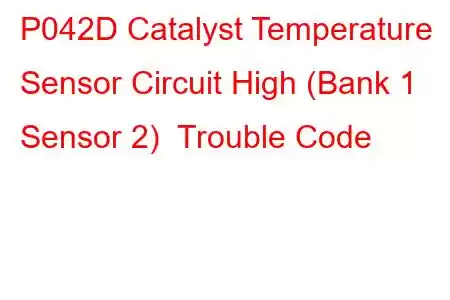P042D Catalyst Temperature Sensor Circuit High B1S2
OBD-II Trouble Code Technical Description
Catalyst Temperature Sensor Circuit High (Bank 1, Sensor 2)
What does that mean?
This diagnostic trouble code (DTC) is a generic powertrain code, which means it applies to OBD-II equipped vehicles that have a catalyst temperature sensor (Subaru, Ford, Chevy, Jeep, Nissan, Mercedes-Benz, Toyota, Dodge, etc.). Although generic, the exact repair steps may vary depending on make/model.
The catalytic converter is one of the most important pieces of emissions equipment on a vehicle. Exhaust gases pass through the catalytic converter where a chemical reaction takes place. This reaction converts carbon monoxide (CO), hydrocarbon (HO) and nitrogen oxides (NOx) - into harmless water (H2O) and carbon dioxide (CO2).
Converter efficiency is monitored by two oxygen sensors; one mounted upstream from the converter and one mounted downstream. By comparing the oxygen sensor (O2) signals, the powertrain control module (PCM) can determine if the catalytic converter is operating properly. A standard zirconium pre-catalyst O2 sensor will rapidly switch its output signal between approximately 0.1 and 0.9 volts. A reading of 0.1 volts indicates a lean air/fuel mixture, whereas 0.9 volts indicates a rich mixture. If the converter is operating properly, the downstream sensor should ready steadily at around 0.45 volts.
Catalytic converter efficiency and temperature go hand and hand. If the converter is working as it should, the outlet temperature should be slightly higher than the inlet. The old rule of thumb was a difference of 100 degrees Fahrenheit. However, many modern vehicles might not show this much of a discrepancy.
There isn't a true "catalyst temperature sensor". What the codes outline in this article are referring to is the oxygen sensor. The "bank 1" portion of the code indicates the problem is with the first bank of the engine. That is, the bank that includes cylinder #1. "Sensor 2" refers to the sensor mounted downstream of the catalytic converter.
Trouble code P042D is set when the PCM detects a high catalyst temperature sensor signal in the bank 1, catalyst temperature sensor 2 circuit. This usually indicates an open circuit.
Code Severity & Symptoms
The severity of this code is moderate. Symptoms of a P042D engine code may include:
Illuminated check engine light Poor engine performance Decreased fuel economy Increased emissionsCauses
Possible causes for this P042D code include:
Faulty oxygen sensor Wiring problems Exhaust air/fuel mixture out of balance Faulty PCM/PCM programmingDiagnostic and Repair Procedures
Begin by visually inspecting the downstream oxygen sensor and the corresponding wiring. Look for loose connections, damaged wiring, etc. Also, check for exhaust leaks both visually and audibly. An exhaust leak can cause a false oxygen sensor code. If damage is found, repair as necessary, clear the code and see if it returns.
Next, check for technical service bulletins (TSBs) regarding the issue. If nothing is found, you will need to move forward to step by step diagnosis of the system. The following is a generalized procedure, as testing for this code varies between vehicles. To accurately test the system, you'll want to refer to a vehicle make/model specific diagnostic flow chart.
Check for other DTCs
Oxygen sensor codes can often be set because of engine performance problems that cause an out of balance air/fuel mixture. If there are other DTCs stored, you'll want to address those first before proceeding with oxygen sensor diagnosis.
Check Sensor Operation
This is best done using a scan tool, or better yet, an oscilloscope. Since most individuals don't have access to a scope, so we will cover oxygen sensor diagnosis u
Read: 43


